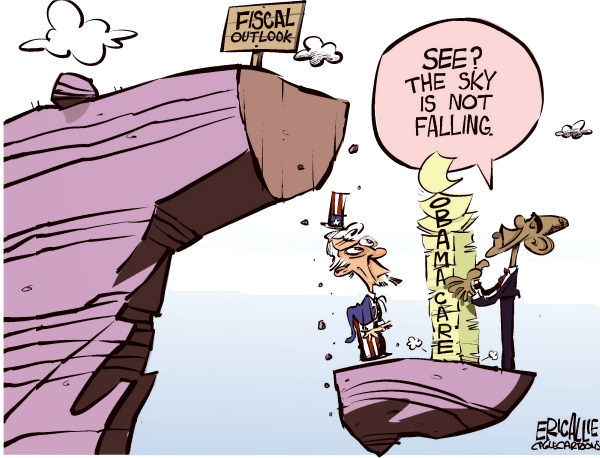
Thanks to ObamaCare the nation’s economic outlook couldn’t be more bleak. Earlier this month the non-partisan Congressional Budget Office (CBO) reported the following:
The federal budget deficit has fallen faster than we expected a few years ago and projected deficits have been reduced relative to what we expected to occur if the policies at that time were to be continued. However, relative to the size of the economy debt remains historically high and is on an upward trajectory in the second half of the coming decade.
The fundamental federal budgetary challenge has hardly been addressed. The largest federal programs are becoming much more expensive because of the retirement of baby-boomers and the rising cost of health care, so we need to cut back on these programs, increase tax revenue to pay for them or take some combination of those actions. Those choices are difficult and the decision as to when we should implement such changes is complicated by the negative they could have on the economy if they took effect while its still fairly weak.
On Tuesday, the CBO reported their 2013 Long Term Budget Outlook which paints an even more grim picture of the nation’s economy:
- During Obama’s Watch, between 2009 and 2012 the federal government recorded the largest budget deficits relative to the size of the economy since 1946 causing federal debt to soar.
Flashback: Remember last month when Obama on “The Tonight Show” with Jay Leno claimed “We’ve seen the deficit cut in half.” Either he was lying or simply just doesn’t know or understand even basic economics and only says what he’s either memorized (told what to say) without the use of his teleprompter.
- CBO projects that federal debt held by the public will reach 100% of Gross Domestic Product (GDP) in 2038 debt would be on an upward path relative to the size of the economy a trend that could not be sustained indefinitely.
Budget Projections For The Long Term:
- Federal spending for major health care programs and Social Security will increase to a total of 14% of GDP by 2038 twice the 7% average of the past 40 years pre-ObamaCare;
- The federal government’s net interest payments will grow to 5% of GDP compared to an average of 2% over the past 40 years mainly because federal debt will be much larger;
- The gap between federal spending and revenues will widen steadily after 2015 by 2038 the deficit will be 6.5% of GDP larger than in any year except in 1947 and 2008 and federal debt held by the public will reach 100% of GDP more than in any year except 1945 and 1946 with such large deficits the federal government will be growing faster than GDP a path that would be ultimately unsustainable.
How long the nation could sustain such growth in federal debt is impossible to predict with any confidence. At some point, investors would begin to doubt the government’s willingness or ability to pay U.S. debt obligations making it more difficult or more expensive for the government to borrow money. Moreover, even before that point was reached, the high and rising amount of debt–will have significant negative consequences for both the economy and the federal budget.
Related: CBO: America Is Going Bankrupt –The American Spectator
U.S. Drops to 17th Place in Worldwide Economic Freedom –CATO
Tweet